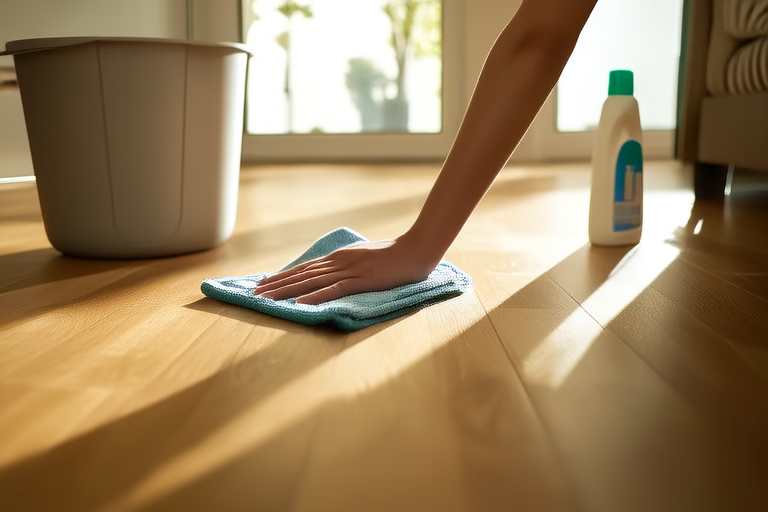Introduction
Hardwood floors are a beautiful and durable choice for any home, adding elegance and warmth to your living space. However, proper care is essential to maintain their beauty and longevity. Cleaning hardwood floors can be tricky because you need to remove dirt and stains without damaging the wood. This guide will walk you through the best practices for cleaning hardwood floors effectively while keeping them in pristine condition.
Understanding Your Hardwood Floor
Before you start cleaning, it’s crucial to understand the type of hardwood flooring you have. Different types of wood, finishes, and installations require different cleaning methods. Common types include solid hardwood, engineered hardwood, and bamboo. Each has its unique characteristics that influence how they should be cleaned.
Solid Hardwood
Solid hardwood is made from a single piece of wood and is more susceptible to moisture damage. It requires careful handling during cleaning to avoid water absorption, which can lead to warping or swelling.
Engineered Hardwood
Engineered hardwood consists of multiple layers of wood bonded together. The top layer is real wood, but the core layers are typically made from plywood or fiberboard. This type of flooring is more stable and less prone to moisture issues than solid hardwood.
Bamboo Flooring
Bamboo is a popular alternative to traditional hardwood. It’s harder and more durable than many types of wood, making it easier to clean. However, it still requires gentle treatment to prevent scratches.
Essential Tools and Products
To clean your hardwood floors effectively, you’ll need the right tools and products. Using the wrong materials can cause damage or leave streaks behind.
Vacuum or Broom
Start by sweeping or vacuuming your floor to remove loose debris like dust, hair, and small particles. This step is crucial as these particles can scratch the surface if not removed before mopping.
Microfiber Mop
A microfiber mop is ideal for hardwood floors because it doesn’t scratch the surface. It also holds water better than cotton mops, ensuring thorough cleaning without over-saturating the floor.
pH Neutral Cleaner
Avoid using harsh chemicals like vinegar, ammonia, or bleach, as they can strip the finish or discolor the wood. Instead, opt for a pH-neutral cleaner specifically designed for hardwood floors. These cleaners are gentle on the surface and effective at removing dirt and grime.
Soft Cloth
For tougher spots, a soft cloth can be used to scrub gently. Make sure the cloth is damp but not dripping wet to prevent water damage.
Step-by-Step Cleaning Process
Cleaning hardwood floors regularly will help keep them looking great and prevent buildup of dirt and stains. Follow these steps for an efficient and safe cleaning routine:
Step 1: Prepare Your Workspace
Ensure all furniture is moved out of the way or covered with protective sheets. This will make it easier to clean thoroughly and avoid scratching the furniture legs.
Step 2: Sweep or Vacuum
Use a vacuum with a soft brush attachment or a broom to sweep the floor. Pay special attention to areas under furniture and along walls where dirt tends to accumulate.
Step 3: Mix Cleaning Solution
In a bucket, mix a few tablespoons of pH-neutral hardwood floor cleaner with warm water. Stir until the cleaner dissolves completely.
Step 4: Mop the Floor
Dip the microfiber mop into the cleaning solution, wringing it out until it’s just damp. Mop the floor in sections, working from one end of the room to the other. Avoid letting the floor become overly wet, as this can cause warping.
Step 5: Dry Excess Water
After mopping, use a dry microfiber cloth or towel to wipe up any excess water. This prevents streaks and ensures the floor dries evenly.
Step 6: Buff the Floor (Optional)
For added shine, buff the floor with a clean, dry microfiber cloth. This step is optional but can enhance the appearance of your hardwood floors.
Dealing with Stains and Scratches
Despite your best efforts, stains and scratches may occur. Knowing how to address these issues can save your floors from permanent damage.
Removing Stains
For minor stains, apply a small amount of hardwood floor cleaner directly to the stain and gently rub with a soft cloth. For tougher stains, such as those caused by food or beverages, you may need to use a specialized hardwood floor stain remover. Always test any product on a small, inconspicuous area first to ensure it doesn’t damage the finish.
Fixing Scratches
Small scratches can often be buffed out with fine-grit sandpaper or a hardwood floor scratch repair kit. For deeper scratches, consider refinishing the entire floor or hiring a professional to do it for you.
Maintaining Long-Term Health of Hardwood Floors
Regular maintenance is key to keeping your hardwood floors looking their best. In addition to regular cleaning, there are several steps you can take to protect your floors over time.
Use Door Mats
Place door mats at entryways to trap dirt and moisture before it reaches the hardwood. This reduces the frequency of deep cleaning and helps preserve the finish.
Apply Protective Coatings
Periodically applying a coat of polyurethane or wax can provide an extra layer of protection against wear and tear. Be sure to follow the manufacturer’s instructions carefully when applying these coatings.
Avoid High Humidity
High humidity levels can cause hardwood floors to warp or buckle. Maintain indoor humidity between 30% and 50% using dehumidifiers or humidifiers as needed.
Conclusion
Cleaning hardwood floors properly requires a balance between thoroughness and gentleness. By understanding your specific floor type, using appropriate tools and products, and following a consistent cleaning routine, you can keep your hardwood floors looking beautiful for years to come. Remember to address stains and scratches promptly and implement long-term maintenance strategies to ensure the health of your floors. With these tips, you’ll be well-equipped to maintain the elegance and durability of your hardwood floors without causing any damage.
